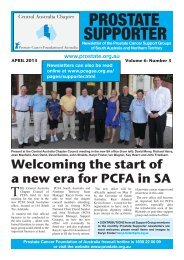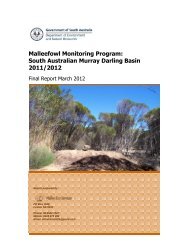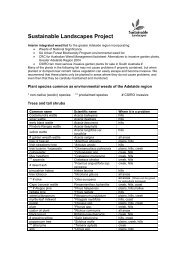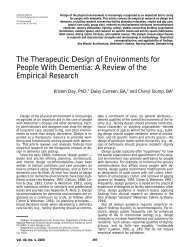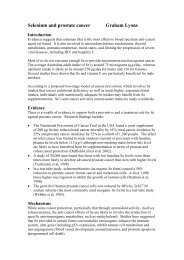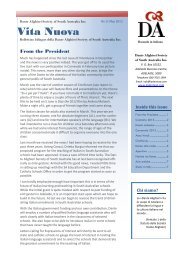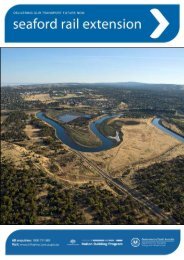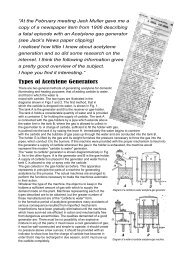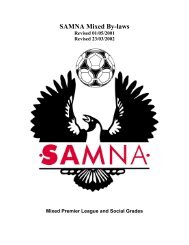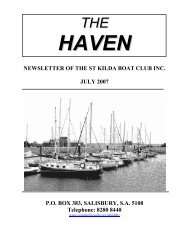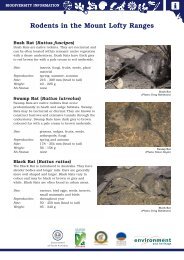SEGments - Communitywebs.org
SEGments - Communitywebs.org
SEGments - Communitywebs.org
You also want an ePaper? Increase the reach of your titles
YUMPU automatically turns print PDFs into web optimized ePapers that Google loves.
SEG<strong>SEGments</strong>Journal of the Scientific Expedition GroupVolume 28 Number 1
SG<strong>SEGments</strong>SGEEScientific Expedition Group Inc.PatronHis Excellency Rear AdmiralKevin Scarce, AO CSC RANRGovernor of South Australia.SEG ExecutivePresident EmeritusC. Warren Bonython, AO.President Dr Richard L WillingChairman Alun ThomasVice-ChairmanVacantSecretary Sarah TelferTreasurerGraeme OatsVolume 28 Number 1, June 2012.ISSN 0816 -6463<strong>SEGments</strong> is the authorised journal publication of the ScientificExpedition Group INC., PO. Box 501, Unley SA 5061. It is publishedfour times a year to promote articles about biodiversity, scientificexploration and ecological research.Copyright 2012, Scientific Expedtion Group INC.Permission will be considered for non-profit photcopying of materialfor personal use and teaching purposes. Written permission must beobtained from the Secretary of SEG.Contact:Scientific Expedtion Group INC.SEG email: scientificexpedtiongroup@gmail.comSEG Secretary: Sarah TelferPO. Box 501, Unley SA 5061Email: sarahtelfer@internode.on.netSEG Treasurer: Graeme OatsEmail: gdoats@bigpond.net.auSEG CommitteeJohn LoveDuncan MacKenzieGraham HillAndrew BarrTrent PorterStuart PillmanHelen JohnsonSEG Website:Http://www.communitywebs.<strong>org</strong>/ScientificExpeditionGroup/default.htmVulkathunha Gammon Ranges Scientific ProjectChris WrightMinnawarra Biodiversity ProjectJanet Furler<strong>SEGments</strong> EditorsAndrew BarrHelen JohnsonSEG WebsiteMichelle TretheweyGarry TretheweyContentsVolume 28 Number 1, June 2012.PageEditorial 1Walking with Warren 3The Nullarbor Expedition 2012 6Interview with Professor Corey Bradshaw 16Minawarra Survey 20Cover Photograph: from South Australian “Advertiser” archives with permission.
EditorialRichard Willingnorth of Adelaide, becoming a world authority onproduction of salt using solar evaporation. It fuelled hisinterest in Lake Eyre.Warren on the Mount Lofty TrackFoundation President of the Scientific Expedition Group,Charles Warren Bonython, AO, died, after a shortillness, on 2 nd April 2012, aged 95.The remarkable life of this great and visionary man wascelebrated at his funeral in St Peters Cathedral withhundreds of friends and family in attendance, as well asrepresentatives of the many <strong>org</strong>anisations with whichhe was associated. All members of his family - Bunty,Simon, Veryan and Alice - contributed to the service.Terry Krieg, long-time friend and walking companion,told the story of Warren, in the days before satellitesand GPS, finding a cache of water in a desert area withno obvious land marks.A proud fourth generation Australian, Warren trained inAdelaide as a chemical engineer, then went to Londonfor postgraduate work. He had to leave UK in 1939because of the outbreak of war, arriving home at thetime of the death of his grandfather, Sir LangdonBonython, founder of The Advertiser, and a participantin negotiations which led to the Federation of Australia.Warren spent WW2 working on explosives inMelbourne, after which he managed the ICI salt-fieldsAfter he retired from ICI in the 1960’s, Warren wasable to concentrate on his passions - love of theoutdoors, bushwalking, exploration and conservation.He completed walking the Flinders Ranges, crossingthe Gammon Ranges, crossing Simpson Desert, walkingthe McDonnell Ranges, walking around Lake Eyre, andlater, Lake Torrens. These desert places usually involvedcarrying water, and he was renowned for the size andweight of his loads. He was a founding member of theNational Parks Foundation (later Nature Foundation),and was instrumental in establishing the Heysen Trail,the walking trail extending 1200 km from the northernFlinders Ranges to Cape Jervis. He was made an Officerof the Order of Australia in 1980. His trekking activitiesextended well beyond Australia and included MountKilimanjaro, the Scottish highlands and Lo Manthangin the Himalayas. He trained regularly and vigorouslywith timed walks from Waterfall Gully to Mount Loftysummit and back, in later years allowing himself an extraminute per extra year of his age.Warren’s association with SEG goes right back to thebeginning – in fact, precedes it. During the 1970’s theAustralian and New Zealand Schools Exploring Society(ANZSES) was formed, with the SA Branch inAdelaide. Warren became president, and I was part ofthe committee. During those early years the group ranexpeditions including the Coorong and Flinders Ranges,leading to a successful Expedition Coffin Bay, in thenewly proclaimed Conservation Park, in the summer of1983-4. Later disharmony with the national body ledto our branch severing ties with ANZSES. Many of usfelt that to disband would be a waste of much expertise,and that our activities should continue, so SEG was bornat a public meeting in August 1984. Warren remainedpresident of SEG until 2003, when he retired and wasawarded the title of President Emeritus. He was a LifeMember of SEG, and remained a Trustee of theScientific Expedition Foundation until the time of hisdeath. Unlike ANZSES, SEG is still active in runningexpeditions.Warren and Bunty were married for 71 years. As thefamily arrived she regarded her role as keeping the homefires burning while Warren was away exploring the aridparts of Australia. One occasion that she “went bush”Journal of Scientific Expedition Group, June 2012, Vol. 28, No. 1. p. 1-2. 1
with Warren was to celebrate 25 years since thecompletion of Walking the Flinders Ranges. It was amemorable trip with Warren, Bunty and Alice, and tenpeople who had been associated with Warren’s exploitsdriving or flying to Mount Hopeless, the most northerlypoint of the Flinders Ranges. Joc Schmiechen cookeda gourmet meal on a camp stove, washed down withfine wine. Flying home the next day, with Bob Mosselpiloting the light aircraft, Warren commented on featuresof the Flinders Ranges passing beneath us. It wassomething very special. He enjoyed celebratinganniversaries, and was a very generous host.Warren went on several of the early SEG expeditions,and led walks after the science work was done. Laterhe settled for a “Presidential visit” to expeditions, for afew days, often driving with Gwen and me. Camped atBalcanoona one chilly morning, snuggled deep in oursleeping bags, Warren left his tent, announcing “Goodmorning, Gwen and Dick, it is 7.30 am, and thethermometer says three degrees” – a mild reproof thatdrove us out of bed!Another occasion involving Warren was the installationof a commemorative plaque on the top of Mt Babbage,in the Northern Flinders Ranges, coinciding with the1986 SEG Expedition Freeling Plateau, and the start ofrelays of High School teams walking the Heysen Trail.With VIP visitors from Adelaide, plus hikers andexpeditioners, more than 70 people were assembledon top of that small hill – probably it’s largest populationever.Warren’s vision, drive and enthusiasm will be sadlymissed, but he has left an enduring legacy of good worksthroughout South Australia. Members of the ScientificExpedition Group are privileged to have known him andhad him as our leader.Richard WillingPresident, Scientific Expedition Group.Contact email: rwilling01@gmail.comPhotograph by: Joc SchmiechenScientific Expedition GroupAnnual General MeetingSeptember 21st at 7:30 pmGuest SpeakerTerry Krieg“Walking with Warren Bonython”AtFullarton Park Centre411Fullarton RoadFullarton SA2Journal of Scientific Expedition Group, June 2012, Vol. 28, No. 1. p 1-2
Walking with WarrenGraeme OatsWe arrived at our final camp site about 1km SE of theOpera site in Trebilcock Creek (Yalkarinha G<strong>org</strong>e) onFriday 2 nd September.Next day we were piped into Beltana and welcomed byPremier John Bannon. That evening we walked to theOpera in our special T-shirts which had printed on theback – “We Walked 100kms to Hear Kiri”Figure 1: In 1988, the trek 100kms to Beltana on theoccasion of Opera in the Outback.Warren retired from ICI Australia in 1966 at the age of 50to further his other interests in conservation and walking.He is credited as the pioneer of the Heysen Trail. I joinedthe Adelaide Bush Walkers Inc (ABW) in April 1981, andI was not surprised to find that he had been their Patronsince 1969.Each year the ABW holds an Annual Dinner and a “Patron’sDay Walk” to which Warren was invited. During 1986-87as the President of ABW I got to meet Warren morefrequently. As a result of this the following events occurred.OPERA IN THE OUTBACK – 1988In 1987, Warren began his planning of a “Walk to theOpera” which was to take place in the spring of 1988 andhe invited me to be his planning assistant.The walk of 100 kilometers was planned to start in theAroona Valley and finish at a site near Beltana, at the“Opera in the Outback” starring Dame Kiri Te Kanawa.Part of the planning coincided with SEG’s expedition toCoongie Lakes.Warren attended the last week of the Coongie Expeditionand arranged for me to travel with him in his 4WD Suzuki(SA EYRE 01) on the return trip, to assist with some “onthe ground” planning of the walk. I recall stopping off nearthe Nuccaleena mines and doing some research of theproposed route north of Oratunga. At our overnight campWarren wasn’t to be denied the pleasures of a “good dropof red” – even in a plastic cup it tasted great.The Walk to the Opera of some 35 people from SA,interstate and overseas commenced on Monday 29 thAugust and was assisted logistically by the Australian ArmyReserves who transported our tents and rucksacks by truck.Journal of Scientific Expedition Group, June 2012, Vol. 28, No. 1. p. 3-6Figure 2: Walkers piped in to Beltana.EYRE’S MYTHICAL lake- LAKE FROME 1990In 1840 Edward John Eyre led expeditions to the FlindersRanges. Warren understood that Eyre was frustratedlooking for a route north and west as his route seemed tobe blocked by lakes. In May 1990,Warren had begun tofollow what he called “Eyre’s Mythical Lakes” whichseemed to surround the Flinders Ranges. He intended towalk north along the eastern shoreline of Lake Torrens,and then south down Lake Frome. Previously he hadwalked along the southern end of Lake Eyre South andLakes Gregory, Blanche and Callabonna.Heavy rain in May 1990 had preceded his walk makingthe shore of Lake Torrens damp, and this impeded hisprogress to such an extent that after a couple of days hereturned to Adelaide. The wheels of the cart were too closeto the frame and had become jammed with mud. Warrencalled a meeting with Richard Willing, Roscoe Shelton(Flinders Camping) and myself to re-evaluate his cart andequipment.Throughout 1990 he continued to follow the eastern shoreof Lake Torrens. Sometime in the winter of 1990 hecontacted me asking if I would accompany him on his finalleg south along Lake Frome.3
In early November we travelled in his trusty Suzuki toMoolawatana where we met Michael and AudreySheehan. My job was to drive the Suzuki along the westernshoreline of Lake Frome whilst Warren set out onto thedry salt lake. Over the next three days I watched Warrenthrough the shimmering haze of the lake. We met for lunchand evening meals and camped alongside the lake. Around3.30pm on 13 November in scorching 33 degree heatWarren said “I’ve done that”. Another missionaccomplished for Warren. We returned to Adelaide thenext day.Mt. HOPELESS – 1993To commemorate the 25 th anniversary of his completionof “Walking the Flinders Ranges” on the 4 th November1968, Warren <strong>org</strong>anised a “re-enactment” of his final day’swalk to Mt Hopeless.On 4 th November 1993, Bunty and Alison Bonython,Richard Willing and myself flew with experienced bush pilot,Bob Mossel from Adelaide in a small Cessna toMoolawatana. Mike Sheahan drove us via station tracksto a spot near Mt Hopeless. Terry Krieg had made hisown way from Port Lincoln. Warren had started his walkearlier that day some kilometres south of Mt Hopeless.We all welcomed him at the summit and then celebratedthe event over a sumptuous meal prepared by bush gourmetcook Joc Schmiechen washed down with various winesand ports including two bottles of Grange Hermitage.I quote from “Walking the Flinders Ranges” by Warren “Istarted up the last slope with hurrying step and kneesthat trembled – but with excitement, not tiredness,although there was every reason for tiredness as I hadcovered more than 17 strenuous miles that day.”and I breasted the last slope walking side by side.”I think that those words sum up Warren’s courage andmental strength to carry feats of endurance that only a fewaccomplish.GAMMONS 1996Warren, Terry Krieg, Joc Schmiechen and I againregrouped in August 1996 to re-enact his first attempt in1946 to explore the then untraversed wilderness of theGammon Ranges from south to north. The 1946 attemptwas thwarted when his walking partner Bob Crocker felland broke a leg. Warren returned in 1947 to complete thecrossing. I clearly recall Warren saying that he wanted todo it in ‘96 (now in his 80 th year) as he was not sure if hewould be fit enough to do in 1997.Figure 4: Joc Schmiechen, Graeme Oats, WarrenBonython and Terry Krieg.We followed his original route starting in Little John Creeknear the foot of Mt McKinlay, north to Mt Changeweather,swinging west past Streak G<strong>org</strong>e, over Four Winds Hill(the 1996 party located a stored cache of wine left thereby a SEG walking party led by Chris Wright, the previousmonth), over Prow Point and into and across MainwaterPound, and onto and over Yankaninna Range to SnakeGully near the old Yankaninna homestead.Figure 3: Terry Krieg & Warren Bonython on Mt HopelessFigure 5: Admiring the view from Prow Point4Journal of Scientific Expedition Group, June 2012, Vol. 29, No. 1. p. 3-6
Figure 6: Celebrating the event at Copley HotelMt. BROWN – March 2002To commemorate the bi-centenary of Capt. MatthewsFlinders sailing along the South Australian coast, SEGsecured funds to re-enact the first ascent by Europeans ofMt Brown (east of Port Augusta).Alun Thomas (SEG Chairman) drove some SEG membersand others in a hired bus from Adelaide to Port Augustaon Friday 9 th March 2002. A walking party of about 10boarded the tall ship “Enterprize” (from Victoria) late thatafternoon which then sailed to a point off Redcliffs, sonamed by Matthew Flinders for the reddish colouring ofthe shoreline. We overnighted on the “Enterprize” andbefore dawn we set out in the ship’s zodiac. Once ashorewe walked in a NE direction towards Mt Brown. It wasexactly 200 years to the day that Robert Brown and othersmade their attempt to climb the then un-named peak. Forus it was hot – well over 30 degrees– on reachingWoolundunga (near the start of the climb) around lunchtime we met Alun with the bus and refreshments. Warren(now aged 85) joined us for this final section of severalkilometres and 700 metres elevation. A tough ask foranyone on a very hot March afternoon. He took it in hisstride.Several hours later we reached the summit (970m) – thiswas my last walk with Warren.Contact Email: gdoats@bigpond.net.auThanks for the memoriesJournal of Scientific Expedition Group, June 2012, Vol. 28, No. 1. p. 3-6 5
The Nullarbor Expedition 2012Helen JohnsonFigure 1: Sunrise over Ifould camp on the Nullarbor Photograph by: Jill TugwellIn late 2010, Harald Ehmann, Alintyjara WiluraraNatural Resource Management Board (AWNRM),Department of Environment and Natural Resources(DENR), approached the Scientific Expedition Group’sCommittee with a proposal for an expedition to theNullarbor region in 2012, as part of a follow-up to abaseline survey done in 1984. Subsequently SEGaccepted the proposal and arrangements proceeded,with a reconnaissance trip being undertaken in March2011, and the actual survey taking place over a twoweek period 31 March-13/14 April 2012.The original survey in 1984 comprised sixteen surveylocations, half of which were in SA and half were inWA. The eastern eight locations in the South Australianpart of the Nullarbor were of interest to the AWNRM/DENR/SEG Nullarbor Expedition 2012. Additionally,some new metrics to measure climate change effectson this relatively pristine environment were to be trialled.SEG’s role was to participate in logistics, site preparation,camp management and the biological surveys led by6AWNRM/DENR scientific personnel. The involvement ofthe Anangu Community was and continues to be foremostin the preparation for this substantive monitoring event(over almost three years), with Traditional Knowledgeprovision, preparation of monitoring sites (pitfalls andphotopoints), community engagement, advising and fieldreconnaissance work.The expedition of about fifty people was divided intofour teams which worked in widely scattered locationsacross the Nullarbor. Each team worked on twelve tofourteen trap-lines/transects in one of the previouslysurveyed locations for the first week, and moved campto another surveyed location (sometimes hundreds ofkilometres away) for the second week. Each team wasindependent of the others, and was largely self-reliant.Sleeping, cooking, scientific work and toilets were intents, and water was carted to each camp. Cookingwas mostly done over open fires with a gas ring tosupplement the cooking. On previous SEG expeditionsonly one location with numerous trap-lines/transects hasJournal of Scientific Expedition Group, June 2012, Vol. 29, No. 1. p. 6-15
een surveyed. On this expedition it was necessary toprepare four sets of all equipment and supplies forcamping, safety and surveying.The four teams were located at: Hughes (HU) andMuckera (MU), HUMU team; Yalata (YA) andMerdayerah (ME), YAME team; Catacombs (CA) andColona (KO), CAKO team and Ifould (IF) andKoonalda (KD), KDIF team. Five of the eight campsiteswere fairly near the coast, with Hughes and Muckerabeing the most northerly and remote locations (Figure2).The article written by Trent Porter in <strong>SEGments</strong> (June2011) about the reconnaissance trip undertaken byHarald Ehmann, John McDonald, Trent Porter and JillTugwell in March/April 2011 makes interesting readingfor Nullarbor expeditioners’.Each of the four teams comprised a Team Leader,science specialists and SEG personnel. The scientificsurvey covered: mammals (1 person); botany (2people); birds (2 people) and herpetology (lizards) (1person). The Team Leader was also one of the sciencespecialists. Three of the scientists, Cath Kemper , TonyRobinson and Lorraine Jansen were on the 1984 survey,and three SEG personnel were included in the sciencegroup. There were four to six SEG people in each campmanagement group led by a Camp Manager. Onenominated SEG person undertook to conduct aninvertebrate survey, using micropits and opportunecaptures.The Team Leaders and Camp Managers for each teamwere: HUMU, Harald Ehmann and Kevin Burrett;YAME, Cath Kemper and Trent Porter; CAKO, RobBrandle and Duncan MacKenzie and KDIF, DaveArmstrong and Jill Tugwell.Harald Ehmann in a post-expedition communicationsent to expeditioners wrote: “Others with widerexperience of monitoring projects have commentedthat this was definitely the biggest field crew andworks program yet in South Australia.”Figure2: Outline of the Nullarbor in S.A. showing locations for surveys.Journal of Scientific Expedition Group, June 2012, Vol. 28, No. 1. p. 6-157
Notes from the NullarborKevin BurrettThe Hughes/Muckera Team was the most remote andfurthest north of the Nullabor Survey. The first week wasspent about 40kms north of the Trans Australia Railway atHughes, on the treeless Plain. The second location wasabout 110kms north of Cook in the transition zone betweenthe treeless plain and the sand dune systems to the north.The first day proved a long one indeed, between a bit ofsightseeing and some flat tyres, we finally arrived about9pm and were greeted with a short but enthusiasticrainstorm. We camped in one of the only features on thatpart of the Plain, a feature (visible on Google Earth) called‘The Dip’ which is an old Paleo-drainage system. It’s about400 metres across, 14 metres deep and about 35kms long.When we were there it was mostly filled with housemice,who hammered the camp every night, discovered custard,scampered over tents and made a general nuisance ofthemselves. They also managed to fall into pitfalls and walkinto Elliots, so the daily catch, (apart from some reptilesand the odd bird) was Mus musculus. The flies, heat, windand house mouse combination proved a challenging oneindeed, especially cooking on the open fire, but we morethan managed and there was a hot meal every night tolook forward to.Despite the sites being re-commissioned some time before,it was a difficult couple of days setting up the lines, andheat exhaustion/dehydration was a factor for all. The goodnature and hard work of the whole team showed throughFigure 4: Notomys alexisand all was well. A lot of Mus were trapped, the vegetationgroup spent a lot of time out in the sun and a lot of waterwas consumed!We were happy to pack and head for Cook where wefuelled, showered and took on a supply (over-supply) ofGatorade sent up on the train from Pt Augusta. We alsore-plenished our water supply. The Muckera camp was apleasant relief from the Hughes camp, with plenty of trees,sandhills and cooler weather. The sites were much easierto set up, and the collection was predominantly ‘native’which made a welcome change from ‘mus’. The campmanagement was made much easier by the improvedconditions. We even managed a poetry and sing-a-longevening around the fire and lots of good ole cameraderie,plus witnessed Harald’s attempts at launching hot airballoons, (unsuccessful), and his manufacturing of a MorleyWinder (successful).We then returned to Cook and on to Ceduna, the tripback being marred by numerous punctures and the nursingof vehicles (without spares) to Nundroo where new tyreswere fitted.In summary then, while the conditions were tough (asexpected) the camps worked well, the goodwill and cooperationwas tremendous and it was an unf<strong>org</strong>ettableexperience. I look forward to the Report with all the datasometime.Figure 3: SEG members David White, Graeme Oatsand Kevin Burrett at Muckera campContact Email: keburrett@tadaust.<strong>org</strong>.au8Journal of Scientific Expedition Group, June 2012, Vol. 29, No. 1. p. 6-15
Notes from the NullarborNULLARBOR DREAMINGHelen JohnsonThere was movement at the depot, for the word had passedaroundThat young Harald was assembling a crew,To roam across the Nullarbor where white men can’t befoundIn search of species plentiful and few.We met at dawn at Hackney – and joined the SEGGOchapsOf hardy expeditioners all keen,To put their skills to practice over campfire, pick and traps,In working with our scientific team.We parted at Ceduna in our groups of roughly ten,To YA-ME, CA-KO, KD-IF went the rest.But I am off to HU-MU with young Harald, Dave andBen,Our chef is cord-de-blue – Kev he’s the best.Excitement it is building as we sing along with Slim,And Graeme points out sights along the road.We see Koonalda Homestead and the Cave so deep within,And gather firewood to top our load.The Treeless Plain confronts us as we head up north toHughes,It’s awesomeness is stunning and surreal.While Phillipa is filming, we all stand around and muse.Then Mel says – Oh! We’ve got to change a wheel.We have Tony, who in ’84 did mammals and reported;There’s Clive and Julia here to count the birds;The veg is loved by Ben and Mel and daily it issorted;And every night our Leader says wise words.We are not too sad to leave ‘The Dip’ at Hughes as it’squite hot.We work long hours – but manage to surviveOn rations and a weekly shower, but has Harald reallyGOTTo tell us “It is thirty eight point five”!So it’s off to Cook and then north-west on Len Beadell’sold track.We leave the plain and move into the dunes.Our camp’s much more than heaven-sent, and we havetime to yack,Round campfires while the sheoaks’ murmur tunes.Now Trent had explained that Muckera would be a greatrelief,And he is right – there’s not a mouse to see;Except of course the Hopping kind, which renews our firstbeliefThat we are in the greatest place to be.When all this ends – I will have my dreams about theNullarbor,A place where Harald Ehmann loves to be.We found so much – the HU-MU team, and learned yeteven more;And then – we met our YA-ME friends for tea!Contact Email: KDolphin@internode.on.netAt sunrise Harald tells us that the wide bluearc out thereWhich lights up the horizon in the west,Is the shadow of the Earth, and we all turnaround and stare–My God! – We’re on a sphere that’s not atrest!The dingos’ howls are thrilling; though at first Ithink it’s chillingAs the packs begin to chorus in the night.They lead our cars along the road; as guidesthey are quite willing,And after dark they pad around our site.Figure 5: The author on Treeless Plain at HughesJournal of Scientific Expedition Group, June 2012, Vol. 28, No. 1. p. 6-159
Notes from the NullarborJill TugwellFigure 6: KDIF group prearing to leave Koonalda for Ifould, from R to L bottom row, Justin Jay, BrianBlaylock, Lorraine Jansen, John Morley, Jill Tugwell, Brian Swann, Margie Barnett, Kevin Wainwright,Dave Armstrong, Top of truck: Leah Kyriacou, Jodie O’Connor.Things to be LearnedAlways be nice and praise up the cook, the meals couldbe worse.Never check if the handle of the Billy is hot with yourbare hand.Never bend over in front of a person with a camera.Never sit on a black toilet seat that is out in the middaysun.Never argue with a man that wants to put a tent up onhis own.If the back of 6 wheeler is full of dust, don’t stand ondownwind side when both wings are opened.Always check if the wings are shut down before movingon to next site.Never get in the way of a man with a shovel.Always get in car & shut door before the driver drivesoff.Always pay attention, the driver doesn’t always knowwhere they are going, even if it is a nice day for a drive,and the story is riveting.Always check what’s in a chair before sitting in it.Vacuum cleaners are not just for cleaning carpets.Always find out where the toilet is before dark.Never swat fly’s with a knife in your hand.Don’t just say oh! When you see a snake or lizard unlessyou have notified others of what this means so they canpounce on it, before is disappears in the sclerolaena bush.Never put you hand in a pit fall until you are sure the onlything lurking in there is a cute little gecko.Some people ARE always right.Instructions can sometimes be interpreted in many waysCute is not always cuddlyThe creatures that surround us are amazing, but not to betrusted.Always take time to be still, listen and learn.Sit back and enjoy the view, it is so worth it.To protect the Author, names have not been mentioned,but you know who you are!I would like to sincerely thank all the members of the KDIFteam for all the help and support I received, both mentallyand physically,I am very proud to have been able to be a part of this survey;I have learned new skills, a few new words, hopefully madenew friends, also the knowledge I have gained may make memore useful on future surveys. I sincerely hope you all enjoyedyour experience of being a part of a worthwhile expedition.Thank you all again and I really hope to see you again sometimesoon.Contact email: jill.t.61@hotmail.com10Journal of Scientific Expedition Group, June 2012, Vol. 29, No. 1. p. 6-15
Notes from the NullarborMax BarrFigure 7: Sunset at MerdayerahI found myself north-west bound to join the YAME clan atour first site, Yalata. I arrived a couple days behindeveryone, due to other commitments in Adelaide, whichrequired the 1000km or so distance from Adelaide to becovered quickly. The drive was tremendously scenic andon arrival I was greeted by the team leader, Cath Kemper,with blue-cheese and crackers and pleasantries.I missed the first day when others were installing the pitlinesand a good show from a lightning storm the nightbefore, that could be seen far off in the distance from thecamp. The first night we ate, discussed the plan for thenext day and called it a night. I woke to the early morningstart of my first day to see that a layer of sea-fog hadrolled in overnight. The sunrise added an extra enchantmentas we drove the 45km to our eastern sites. On arrival inthe scrub, the low lying fog condensed on the vegetationas the day warmed with the result of a rain-like experienceon the scrub. I devastatingly realised I had left my cameraat camp. I thought wishfully that maybe the fog/rainconditions would repeat every morning, but alas, I waswrong.Checking traps and actively searching the sites for signs oflife were duties that fell into part of a familiar routine. Bird-oSuper-team, Graham and Graham, set the pace as weactively searched for signs of mammal and reptile life. Theeastern sites of the Yalata camp were an interesting mix ofMallee woodland. So much so, in fact, that the study ofthe understorey created an opportunity for study for aregional botanist all the way from Berri. The expertise ofJohn MacDonald helped regional ecologist, Ellen Ryan-Colton, to learn about the species which were missing fromthe understorey of the Mallee in the Riverland. TheRiverland Mallee has long been degraded by overgrazing,both by feral and commercial animals.It was beautiful Mallee country that provided the team withcaptures of pygmy possums, reptiles and sightings ofslender-billed thornbills. The travelling distances betweensites, both on and off-road, produced chance sightings ofbustards and camels for the father/son combo, Austin andGeoff Cook. Cath collected specimens of bats around anold water tank and between some large Eucalypts on theedge of the Mallee. We had some visitors of theherpelogical kind along the way too - snakes meanderinginto camp, legless lizards interrupting dinner and in onecase, a baby brown snake that was hand-caught early inthe morning through mistaken identity by the snakewrangler Mr. John Love.The days at Yalata camp were some of the most varied Ihave ever experienced whilst camping. Each day Iexperienced different condition in the weather, the flora,the fauna and condition of flies. March flies were everpresentand came in plague-like proportions for at leasttwo days. When the March flies stopped (because we hita few days of high 30’s low 40s… in the shade, might IJournal of Scientific Expedition Group, June 2012, Vol. 28, No. 1. p. 6-1511
add), then the little blowflies took their place. The onlything slowing down their constant buzzing was the dayswhen the wind was strong enough to keep them moving.The western sites of the Yalata camp were coastal sites.The sites stretched along a beach track that accessed afew camp sites. The local owners have erected signs andmaps painted with what appeared to be house paint onthe bonnets of old cars. This presented a very curiouscontrast in an otherwise open grassland outback scene.Sandy undulating open grasslands morphed into red sandyswales as we headed seaward. As the soil changed to amore sandy limestone, the change in vegetation wasremarkable. Unfortunately since I had f<strong>org</strong>otten my cameraa second time, you’ll have to take my word that the dunesright at the beach, and the ferocity of the coastline wereremarkable. The Western sites produced different typesof captures such as Psuedoemys sp. (native rodent) and afew rare lizards.Before we knew it, it was time to move on. Sites werepacked up systematically and the camp even moreenthusiastically, as we made a team decision to make it toNullarbor earlier than the expected meeting time to scorefirst dibs on the showers. The heat, the dust and the Marchfly bites were getting to everyone. I wasn’t feeling too badbut the rest of the YAME team had an extra shower-lessday on me. I even made it another whole week beforegetting a dip in the ocean... it was well worth the wait!The change-over went well at the Nullarbor Roadhouseas we exchanged stories with SEG and DENR membersfrom other camps, refuelled the cars and treated ourselvesto the spoils of civilisation. All cleaned up and re-fuelledwe said goodbye to Graham Carpenter and the Cooksand welcomed Lyn Pedler to the team. The convoydeparted west towards the Merdayerrah sand patch alongthe Eyre Highway in the midst of the treeless plain.We turned just before the border of Western Australia anda little way down the historic Old Eyre Highway weestablished our campsite; and what a campsite it was! Ithought Yalata was good, but Merdayerah was gold. Weset up camp and retired after some dinner, and I think thisis as good a place as any to give a great thankyou to Rayand Trent who produced the best camp menu I have evertasted. I f<strong>org</strong>et the order of the meals that we enjoyed, butit was all fantastic.Easter Sunday was a day of hard work setting up the sites.It wasn’t too hot, which was nice, and there weren’t anyMarch flies (that I noticed), and the ground becamegenerally less consolidated as we moved along in the day.We prepared all the lines just before we lost the last ounceof sunlight for the day and the Easter bunny or bilby left uslittle gifts to keep the team going. I think everyone sleptwell that night and the next morning we were greeted witha nought reading on the thermostat. That’s right! A low ofzero degrees Celsius overnight.North to south was the bearing of the sites this time, andthe contrast between Site One and Six was marvellous.North and inland there was a lake of Austrodanthonia(wallaby grass), which was the botanists easiest task toFigure 8: Spinfex in seed at Yalata12Journal of Scientific Expedition Group, June 2012, Vol. 29, No. 1. p. 6-15
survey. This was a welcome break from the very detailedsurvey method that was implemented on this survey.Everyday en route to site six we had to pass a sinkhole, acave which held an underwater lake of significance thataccommodated a bacterium under study. The cave diverswere quite happy to exchange expedition details andinformation with us and even retrieve specimens from thecave. These included owl pellets, bird and bat remains,and even a dead snake.The north sites produced a Notomys mitchelli ( hoppingmouse), Ctenophorus pictus (painted dragon), moresightings (six in fact) of Ardeotis australis (AustralianBustard) and an alleged dingo, who either really liked ordisliked John Love’s methylated spirits filled ant-collectingmicro-pits as it dug up and masticated nearly every one.In the south, the highlight of vegetation change was from aMallee type woodland into thick forests of Melaleucagrowing on top of the sandy flats. I don’t recall too manydetails of animal captures on this second camp, mainlybecause I had a good run working with the botanists.Running ahead of schedule meant that one afternoon wehad a few hours off. An opportunity presented itself thatwas too good to pass up; to go and retrieve a southernright whale’s baleen that had washed ashore on a beach atEucla.We headed into the border town of Eucla to find the whale’sbaleen and vertebrae. It was collected by local residentsTony and Raza who lived in a palace on top of a cliff top.A local’s tour of Eucla was offered and away we went onthe back of a open-trayed V-8 beach buggy. The localguided tour consisted of the old trading post and stockyardsplus a drive along the beach. Exploration of the beach wasfruitful with Cath finding a whale fibula. The was also chancesightings of some Emus and very charismatic MajorMitchell’s parrots that were all perched in a massive oldshe-oak planted next to the trading post.For myself, this was the icing on the cake on this TeamYAME expedition. My last night on the Nullarbor underthe starlit skies. The last morning to wake up to Trent’sbooming voice and breakfast jokes. We packed up thesites systematically with not too many captures. Tried tohunt down some Nullarbor magpies and currawongs butto no avail. And that was it, my time on team YAME hadcome to an end. A detoured scenic route down the EyrePeninsula required me to leave half a day before the restof the gang so I packed up, said the appropriate goodbyes,cried a little and headed east... Adelaide bound.Wow! What an adventure.The main thought that keptpopping into my mind as I was driving back. The crewwas fantastic; we had a lot of laughs, shared some grandexperiences and I even learnt a few things! So, membersof YAME... Thanks for having me and I’ll see you soonin some scrub near you.Contact email: maxbarris@gmail.comPhotography: Max BarrFigure 9: Warbala CaveJournal of Scientific Expedition Group, June 2012, Vol. 28, No. 1. p. 6-1513
Notes from the Nullarbor Duncan MackenzieFigure 10: The Nullarbor Catacoombs/Koonalda Team: Back Row L to R: Duncan MacKenzie (S), AnitaSmyth (D), Rob Brandle (D), Kirrily Blaylock (D), Caroline Bishop (S), Joel Allan (D), Kate Graham (D),Marilyn Wilkins (S), Annette Vincent (S), Janet Furler (S), Jaryd Holmes (S) Front Row L to R: PhilippaSchmucker(D), Christina Pahl (D), Ric Williams (S)The Catacoombs/Koonalda Team was composed of sixSEG and six DENR members. This was an ‘unusual’composition for a SEG expedition, and it proved to beextremely successful. The scientific work was basically ledby DENR members and SEG provided assistance at trapsites each day and looked after camp <strong>org</strong>anization, includingcooking duties.The botanists spent the most time out in the field, and SEGwas able to provide two members each day to assist in thework. In no time at all, the joint SEG/DENR effort ‘blended’into one cohesive and happy team with few lines ofseparation.The first camp was set up in the Catacoombs area, famousfor its cave systems. The landscape was generally treelessbut we did manage to find a small belt of trees in which toerect our first camp. All personnel assisted with camp setupand once the cooking/eating tent and science tent wereerected, proceeded to get their personal tents erected.During the evening meal a rainstorm accompanied by winddescended on camp and 12 people stood around the tentholding the roof and walls down to prevent it blowing away.Fortunately, this was the only rain experienced by the team.Prior to arrival at Nullarbor, we were told that virtually allour cooking would be done in camp ovens in pit fires.Accordingly, we commenced digging a pit and onlymanaged to dig down about a ‘hands span’ before givingup after removing a huge pile of rocks from the ground -where were the sandy conditions we had been promised.After that grueling digging session, all but one meal wasprepared in the comfort of the tent on gas stoves.The first order of business was to commence setting upthe survey sites and everyone pitched in to help. After settingup the second site, team members specialized in certainelements of the installation process and we became a ‘welloiled machine’- from then on, site set-up was a ‘piece ofcake’ and took a minimum amount of time. One thing thatdid not go according to plan, was the use of a new industrialvacuum cleaner that was to be used to suck the sand outof the pitline buckets- the buckets had been recommissionedsince the original 1984 surveys wereundertaken by DENR. However, some moisture had14Journal of Scientific Expedition Group, June 2012, Vol. 29, No. 1. p. 6-15
obviously entered the buckets and many required the useof a crow bar to break up the ‘cement hard’ sand.Mammals, reptiles, birds, vegetation and ants weresurveyed. The Catacooombs team recorded a total of 18bird species and the two most common birds were theNullarbor Quailthrush (34) and the Rufous Fieldwren (33).Mammals were a disappointment and only two nativespecies were recorded – Sandy Inland Mouse and theSouthern Hairy nosed Wombat. There were, however, 36house mice trapped. Reptiles proved to be more interestingwith 14 species being recorded, the Nullarbor EarlessDragon being the most common.A welcome respite from pitline work was a visit to the oldKoonalda shearing sheds and their outbuildings. These werelocated near to some of our sites and afforded us theopportunity to set-up bats traps over an underground watertank – no bats were trapped.The Catacooms/Koonalda team were a happy bunch, andwho wouldn’t be with the great menus that Trent prepared.One of the things about a SEG expedition is that no onewill ever go hungry, and even out in the Nullarbor‘wilderness’ there were no gripes about the quality andquantity of good food.The Nullarbor was an interesting trip made even more soby the combination of SEG and DENR personnel – a greatcombination that shared all the duties in both field and camp,making it a very pleasant and memorable two weeks.Figure 11: Rob Brandle setting up the ANABATsystem to record bat calls at Koonalda Water tank.Figure 12: Bird-o Bea Rogers discussing sites withRob Brandle at Koonalda Shearing ShedsAt the end of week 1, and following a brief stop at theNullarbor Road House (for a welcome shower) we movedon to the Koonalda site which was located in mallee scrubvery near the famous Dog Fence. It was great to be amongsttrees again and the difference in the vegetation wasimmediately apparent by the number of bird species seen(49). The honeyeaters were the most common and activebirds around camp. Mammals were still ‘scarce on theground’ but house mice were still active (42). Reptiles werenot as well represented at the Koonalda sites and a totalof 12 species were recorded.The sandy soil at our campsite did allow us to build a pitcampfire and on the one night it was in operation, ourDENR leader, Rob Brandle, prepared scrumptious campoven pizzas. Fairly constant wind prevented further use ofpit fires at this camp.Figure 13: The dusty track along the Dog Fence nearthe Koonalda Camp.Contact email: mackenzie@picknowl.com.auPhotography: Duncan MackenzieJournal of Scientific Expedition Group, June 2012, Vol. 28, No. 1. p. 6-1515
our crops. What is the relationship between agriculturalproduction yield and the configuration of the landscape interms of its native species composition?Then there are other components, for example when youare going to restore a landscape to regenerate or preservesome ecosystem services, how do you do it so that thelandscape is resilient under a changing climate?All of these big scientific questions, about how to restore/conserve processes while maintaining some sort of longtermresilience, are to me the most important aspects ofconservation ecology right now.SEG: Are you able to work in those areas?C.B: I’m already working in the carbon space. We havequite a number of projects and proposals for projectslooking at how carbon is affected by landscape and forestconfiguration, and I still haven’t really gone into thepollination area. I am a farmer myself with a very smallfarm. I have bees and I am interested in how they affectmy crop yields. And so I am looking from the bottom upas well as from the top down.“As you cut down forests you increasethe risk of catastrophic floods”Another thing I have dabbled in is flood mitigation;understanding how forests affect flood frequencies andflood magnitudes. There was always a bit of a legend thatforests mitigated flood frequencies, but there is pretty strongevidence now, and we have found global scale evidence,that forests do indeed mitigate floods. As you cut downforests you increase the risk of catastrophic floods, withall the things that come with that: deaths, property damageand displacements.SEG: Is that because the trees themselves slow downthe flow of water?C.B: It’s very complex from a hydrological process, buttrees affect soil composition, run-off, evapo-transpirationand they also affect the formation of water channels. Allthese things combined mean you get much more variancein water supply when you reduce forest cover. There areactually still hot debates in the hydrological literature abouthow it works, but it certainly does work at broad spatialscales.SEG: Is global warming a major threat tobiodiversity?C.B: Yes it already is. I’ll give you a really personal exampleand this relates to citizen science. The Virtual Herbariumof Australia has one of the world’s largest collections ofmacroalgae (seaweeds) and as it turns out, Australia hasone of the world’s highest diversities and endemicities ofmacroalgae species (‘endemicity’ means found only fromhere). Most species follow a latitudinal gradient in diversity,such that the closer you get to the tropics, the higher thenumber. For seaweeds it is actually the opposite, and thereare higher numbers of species in the temperate zones.Most people don’t think about seaweeds, but they areessentially the forests of the sea and they provide shelterand structure for invertebrates, which are in turn food forfish. So seaweeds really are the infrastructure of the coastalseas. Without seaweeds it would be just like cutting downa forest, with the consequent complete loss of an ecosystem.We are now seeing (through the collections in the VirtualHerbarium) whole community shifts down the east and westcoasts of Australia as the waters warm. In the last fiftyyears waters have warmed by almost one degree on theeast coast alone and the seaweeds are tracking thosetemperature changes.“ We are looking at possibly wholesaleextinctions of macroalgae communitiesacross our southern coasts within thenext fifty to one hundred years”Seaweeds need a certain depth of water in which to grow,and they need certain kinds of hydrological regimes andoceanographic currents, and so they can’t be pushed outinto the middle of the ocean. Essentially, seaweeds canonly track so far south before they drop off the continentalshelf and go extinct.We are looking at possibly wholesale extinctions ofmacroalgae communities across our southern coasts withinthe next fifty to one hundred years, with the associatedloss of entire invertebrate and fish communities. So, it isvery scary stuff.The marine ecosystem is a really classic example of globalwarming. Right now the oceanography off the east coastof Tasmania is pretty much the same as that which was offsouthern New South Wales in the 1950s. Everything istracking south.SEG: How do you see global warming affectingterrestrial systems?C.B: Terrestrially speaking, we have changed fire regimesJournal of Scientific Expedition Group, June 2012, Vol. 28, No. 1. p. 16-19.17
and our heat-wave dynamics. People don’t understandthat it is not the mean value of a parameter that counts, it isthe extreme values. Take temperature for example: if themean temperature is 25 degrees C it is not really stressfulfor anything, but when the temperature hits 40 degreesand it lasts for three weeks, then you see die offs; of redgums,people, birds; all sorts of things drop off when youhave these extremes. If the extremes are infrequent enough,you can get diebacks and then recovery, but as thefrequency of these extremes increases, there is not enoughtime for recovery between the extreme events and sobasically you are knocking populations on the head at afaster and faster rate and with no time for a recovery, andpopulations can go extinct.We are seeing right now with heatwaves that they are gettingmore and more frequent and lasting longer. The averagetemperatures might climb by only 0.5 degrees over fiftyyears, but you’ve increased the frequency of yourheatwaves by ten times. This is the scary part, and we areseeing it across the world.“ in south-east Australia, we have someof the highest rates of warming in theSouthern Hemisphere, and it’s gettingworse.”We haven’t had the kinds of increases that are beingexperienced in the Northern Hemisphere: in the high Arctic,in Russia, Siberia, and North America. Temperatures haverisen in some areas by well over one degree. But in southeastAustralia, we have some of the highest rates of warmingin the Southern Hemisphere, and it’s getting worse. Weare also tracking at the highest emissions rates ofgreenhouse gases. Everywhere ecologists look we areseeing effects.SEG: Should we conserve as much biodiversity aspossible, or should we target species to be conserved?C.B: I’ve written a lot about prioritisation, basically smartdecision making, and so I use the concept of conservationtriage a lot. Triage is a wartime term where the medicalteams assess the probability of survival of each woundedsoldier, and then invest their time and effort into the soldierswho are most likely to survive. It’s very Machiavellian.We use the same concept in conservation. If something isso far gone that investing even millions of dollars andspending lots of time might save it, only might, then it isprobably better to take that money and invest it in somethingwhere we can potentially save thousands of species for alittle effort. For example, by buying up land to ensure thata forest is not cleared.“Yes, some things will have to beabandoned. It’s a tough call, but wehave to do it”It is a cost-benefit analysis, and it is very unemotional.People who are dedicated to conservation don’t want tosee anything go extinct. I don’t want to see anything goextinct, but I am a pragmatist. I know things are goingextinct all the time, but they are going extinct at a higherrate because of us. We can slow that rate down by investingsmartly, and I don’t think we are nearly at that point yet.We have to get over some of the emotional baggageassociated with it. Yes, some things will have to beabandoned. It’s a tough call, but we have to do it.In the decision-making process there are a lot of ways toassess conservation value. Total numbers of populationsis one layer, but we also have to weight by socio-economicvalues, by the infrastructure components, by keystoneaspects, and by resilience (how susceptible a populationis to decline).SEG: How are mathematical principles used in thescience of conservation?C.B: Cost-benefit analysis, where you have to quantifytrade-offs with economic benefits, or quantify relationshipsto productivity is a classic application of economicmathematics.Everything we do in science, no matter what the science is– medical research, physics, chemistry, ecology – comesdown to measurements. Measurements produce numbers,and there is only one discipline that deals with numbers –mathematics.You know people use a colloquial expression “It’s not rocketscience”, but rocket science is pretty straightforward comparedto ecology. In ecology you are dealing with thousands,sometimes millions, of species in a single system, interactingwith each other; individuals within a population all respondingto environmental cues (things that we can barely measure ordetect; pheromones for example), and then we try to modelmathematically these systems and predict how they will changeunder certain perturbations. When you are trying to distil millionsof relationships it becomes chaos theory, which is a disciplineof higher mathematics.“ Maths is at the heart of ecology.Maths is at the heart of conservation”18Journal of Scientific Expedition Group, June 2012, Vol. 29, No. 1. p. 16-19
Long-gone are the days of the naturalist roaming aroundrecording when the bees start to visit the flowers and thebirds start to sing. Data collection is an importantcomponent of ecology, but it is not sufficient. Data thenhave to be analysed using fairly complex mathematics totease out the patterns. There are all sorts of considerationslike measurement error; there is huge variance becausenot all individuals in a population do the same thing; andthey are all responding to different cues. Pulling those outrequires excellent mathematical skills. So maths is at theheart of ecology. Maths is at the heart of conservation.If you think that you can do a university degree in ecologybecause you are not good in maths, you are completelywrong; it is exactly the opposite. You have to be good inmaths today to do these sorts of thingsSEG: Do your other colleagues have such a strongbackground in mathematics?C.B: I think there is a tradition of ecologists being lessnumerate than they should be. I will be the first to admitthat our mathematical training in universities is inadequate.Even the Group of Eight universities have mostly done awaywith advanced mathematics in their entry-level prerequirementsfor students. It is going the opposite way thatit should be. We need to get much better mathematicalinstruction right from primary school, through high schooland then much more in the undergraduate years so thatpost-graduates, the PhD students who are the nextgeneration of scientists, actually have the tools that theyneed.SEG : The data which the Scientific ExpeditionGroup collects is provided to the Department of theEnvironment and Natural Resources, the SouthAustralian Museum and the State Herbarium, andeventually ends up in the South AustralianBiological Databases. Does data from thesedatabases get used in your work?C.B: I haven’t dabbled too much in the South Australiandatabases, but I do know that other colleagues in theUniversity of Adelaide’s Environment Institute are usingthese and getting them online and cleaning them up. I haveused other datasets, and I mentioned the Virtual Herbariumwhich is collected by amateurs and professional together.Recently I’ve started using citizen science data from theReef Watch Group. This is a group of divers <strong>org</strong>anisedthrough the Conservation Council of South Australia whodo fish surveys along transects over time. A problem withthe database is that it is not as standardised as it shouldbe, and so it is a bit messy. In using databases we have toaccount for such things as the amount of effort that’s goneinto searching for different species, whether people arevisiting at regular times, and to account for expertisedifferences because it is really difficult to be definitive aboutsome species unless you are an expert.With all those things together you can see why the statisticalcomponents are so essential to control for all those sourcesof uncertainty and start to quantify patterns.It turns out that the more people you have looking, and thelonger the time series, the more chance you have of findingpatterns in data. And so yes, citizen science databases areuseful. I think a lot of citizen science has been fairly adhoc, and it hasn’t necessarily been standardised well fromthe outset. As techniques change and people become moreaware of the sampling biases, they get better.SEG: Thank you very much for your time todayProfessor Bradshaw.Interviewer’s Notes:Professor Bradshaw has recieved many Awards, Grantsand Fellowships from the Australian Research Council andother bodies.Webpage:www.adelaide.edu.au/directory/corey.bradshawProfessor Bradshaw wrote an interesting article “CanAustralia Afford the Dingo Fence?” on18/5/12 in his Blog entitled ConservationBytes.comJournal of Scientific Expedition Group, June 2012, Vol. 28, No. 1. p. 16-19.19
Minnawarra Survey AprilJanet FullerThe autumn survey has been completed, with resoundingsuccess. The weather was lovely, we had many greatpeople assisting and learning, and a huge number of littleanimals recorded.The PeopleOver the 5 days we had 36 people coming in and out,some for half a day, some for the whole time. Three Scoutsfrom Victor Harbor camped for 2 nights. In all 449 hourswere donated over the survey – a fantastic effort!The WeatherThe survey began with warm weather and dry conditionsas we waited for the rain to start the season. The first twodays stayed warm and dry. Day 3 began to cool downand some rain fell. Day 4 was quite drizzly and resulted inquite a few wet and soggy people. Pack-up day was coolbut not wetting, which was a bonus. This change in weathergave us quite distinct populations recorded from the wetand the dry periods, as explained further on.Wed 18 April 2012.Temp 17-28, wind light N-NW, cloudy, dryThu 19 April:Temp 17-27, wind light NE-NW, clear, dryFri 20 April:Temp 18-27, wind light NE-SE, clear and dry at first,change with scattered showers in afternoon, 11mm of rainovernightSat 21 April:Temp cool, 12-15, wind moderate W-NW, heavy cloud,high humidity, 6mm of showers continuing through the day.Sun 22 April:Temp cool, brought out a wide range of animals.The AnimalsWe had a good number of the usual species, with the moreunusual being an Echidna who was wandering along thefence at site 2 and obliged us with good photo opportunities.We also caught a Lerista bougainvillii, a South-easternSlider. This is a skink who spends its life burrowing underthe leaf litter. As a result it has very small underdevelopedlegs which it tucks into its body while slithering around.In all we caught 161 mammals, 26 reptiles and 10 frogs.We recaptured 29 mammals from previous surveys, and,with repeat visits during this survey we handled 285 animals.There were 28 feral house mice and 2 feral rats. One ofthe rats had the creamy white belly of the recently identifiedPhoto by Peter Robertson © Museum VictoriaFigure 1: Lerista bougainvilliiRattus tanezumi, the other had a grey belly more likeRattus rattus. Both of them will be given to the SAMuseum to aid the genetic study of these species.The rain which began on Friday afternoon indicated theeffect the weather can have on which animals are caught.All but one of the frogs (all Crinea signifera) were afterthe start of the rain. Of the skinks (22 Lampropholisguichenoti, one each of Eulamprus heatwohlei,Hemiergis decresiense, Pseudomoia entrecasteauxii andLerista bouganvillii), all but three were caught beforethe rain. Less explainable is the appearance of the swamprats (Rattus lutreolus) with the rain. They must still havebeen active in the dry weather, but maybe not wantingpeanut paste. However, perhaps a little cold enticed themammals into our Elliott traps over Saturday night. Wefound a bumper catch of 72 out of 120 traps occupied onSunday morning!Our birdos also did their usual quiet efficient job, wiselypicking the warm and sunny day before the beginning ofthe wet.Our next survey will be on the October longweekend – Saturday 29th September toWednesday 3rd October. Love to see youthere!Contact Janet 0419 842 667,thefurlers@gmail.comRichard 0408 807 517,rwilling01@gmail.com20Journal of Scientific Expedition Group, June 2012, Vol. 28, No. 1. p 20
SE<strong>SEGments</strong>GSEGSCIENTIFIC EXPEDITION GROUPThe Scientific Expedition Group (SEG) came into being at a public meeting on 21st August 1984. Members receive regularinformation on SEG activities and expeditions. Membership is open to any persons, family or <strong>org</strong>anisation interested in thefollowing aims:* The promotion and running of expeditions of a scientific, cultural and adventurous nature.* The furthering of knowledge, understanding and appreciation of the natural environment.* Promotion of the values and philosophy of wilderness.* Enabling people to learn the skills required for planning and running expeditions, and to develop sound field techniques.APPLICATION FOR MEMBERSHIP AND MEMBERSHIP RENEWAL for 2012SUBSCRIPTIONSAdult member - - - - - - - - - - - - - - - - - $30.00Concession cards/ student------ - - - - - -$15.00Family membership - - - - - - - - - - - - - $35.00Corporatemembership - - - - - - - - ----- $35.00Name. . . . . . . . . . . . . . . . . . . . . . . . . . . . . . . . . . . . . . . . . . . . . . . . . . . . . . . . . . . . . .. . . . . . . . . .Address . . . . . . . . . . . . . . . . . . . . . . . . . . . . . . . . . . . . . . . . . . . . . . . . . . . . . . . . . . . .. . . . . . . . . . . . . . . . . . . . . . . . . . . . . . . . . . . . . . . . . . . . . . . . . . . . . . . . . . . . . . . . . . .Telephone (H) . . . . . . . . . . . . . . . . . . . . . . . . . (W) . . . . . . . . . . . . . . . . . . . . . . . . . . .E-mail . . . . . . . . . . . . . . . . . . . . . . . . . . . . . . . . . . . . . . . . . . . . . . . . . . . . . . . . . . . . . .Details of scientific, cultural, and adventuring or other relevant skill or interests you may beprepared to share with the group:. . . . . . . . . . . . . . . . . . . . . . . . . . . . . . . . . . . . . . . . . . . . . . . . . . . . . . . . . . . . . . . . . . .Send a cheque ( Scientific Expedition Group Inc.) with a Photocopy of this page toThe SecretaryScientific Expedition Group Inc.P.O. Box 501Unley S.A.5061
Visit the NEWScientific Expedition GroupWebsiteWatch this space for thenext expeditionhttp://www.communitywebs.<strong>org</strong>/ScientificExpeditionGroup/default.htm



